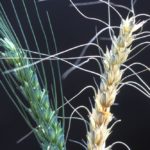Tag Archives fungicide

Resistance management is of utmost importance for cucurbit downy mildew
Changes in fungicide regulations have reduced the available treatments

Digital supercluster backs precision fungicide development
Project aims at wheat leaf rust, reducing pesticide load

Making better spraying decisions with low-cost, early fungal disease detection
Spornado is being tested across Canada, especially in higher value vegetable crops

New fungicide launched for fusarium head blight control
Syngenta’s Group 7 ADEPIDYN to be released to all crop markets in 2020

Trial aims to better detect late blight pathogen before it infects tomatoes
The three-year project will evaluate early detection, management approaches and potential benefits

Bee-based disease prevention
Inoculating flowering plants with insect-delivered fungus can help limit disease

Sprayer power: Is electricity the next big thing in spray adjuvants?
Positively charging spray droplets can help them stick to plants, but droplets need to be small

Pearce: Multiple modes of action an emerging reality for fungicides

UPL to buy crop chem firm Arysta



